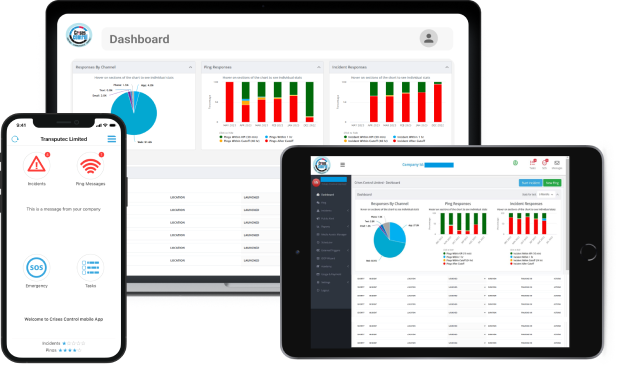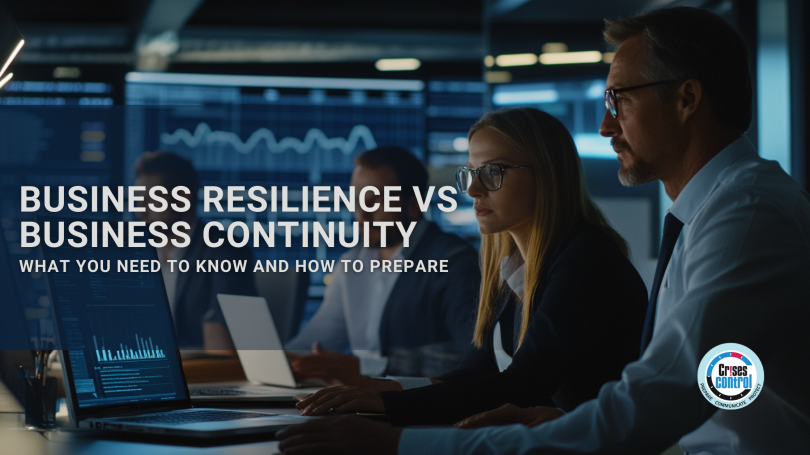Written by Anneri Fourie | Crises Control Executive
Business Resilience vs Business Continuity: Why Your Current Strategy Might Not Be Enough
Most organisations have some form of crisis or continuity plan. But here’s the issue: plans often sit on a shelf, gathering dust until something breaks. When a real disruption hits, these static plans are often too rigid to be useful. They may help restore operations, but they don’t always help you adapt or grow stronger in the aftermath.
This is where many organisations stumble. They focus on getting back to “normal,” rather than becoming more adaptable. That’s the key distinction between business continuity and business resilience, and why understanding the difference matters now more than ever.
In this article, we’ll break down the difference between business resilience and continuity, show you what a stronger preparedness strategy looks like, and explain how Crises Control helps organisations build lasting resilience with the right tools and thinking.
Business Resilience vs Business Continuity: What’s the Real Difference?
Although the two concepts are closely related, they serve very different purposes, and understanding them is vital to building the right strategy.
Business Continuity
This is about keeping essential operations going during and after a disruption. Think of it as your playbook for specific scenarios: server failure, network downtime, a flood in your office. Business continuity focuses on recovery — minimising downtime, restoring services, and ensuring critical functions don’t stop.
Business Resilience
This goes further. Resilience is your organisation’s capacity to adapt and evolve in the face of unexpected challenges. It’s not just about recovering — it’s about responding in a way that makes your organisation stronger, more agile, and more capable of navigating future shocks.
Key Differences at a Glance
| Aspect | Business Continuity | Business Resilience |
| Focus | Maintain critical functions | Adapt, learn, and improve under pressure |
| Scope | Specific incidents and recovery | Organisation-wide adaptability |
| Timeframe | Short-term, during crisis | Long-term, before, during, and after disruption |
| Approach | Planned, scenario-based | Proactive, dynamic, flexible |
| Outcome | Return to operations | Stronger, smarter post-crisis organisation |
In short: continuity gets you back on your feet — resilience helps you move forward.
Why Relying Only on Continuity Planning Isn’t Enough
Traditional continuity planning works best for predictable events. But the world is no longer predictable. Threats are more complex, more connected, and less forgiving than they used to be.
Take the COVID-19 pandemic. It wasn’t just a business interruption — it rewrote how companies operate, collaborate, and serve customers. No playbook could have covered all that. Businesses that survived and thrived were those that adapted quickly: switching to remote work, updating their supply chains, supporting employee wellbeing, and embracing digital tools.
This is what resilience looks like. It’s a mindset, not just a manual.
Emergency Preparedness for Businesses: Moving Beyond the Checklist
Emergency preparedness often gets reduced to tick-box exercises — risk logs, fire drills, policy documents. But true resilience comes from a joined-up approach across your entire organisation.
Here’s what resilient businesses build into their strategy:
- Scenario testing beyond the obvious: Think outside typical risks. What happens if your cloud provider fails? What if a supplier in another country goes offline?
- Real-time communication tools: Can you reach everyone instantly when it counts? Not just emails — SMS, voice, app notifications.
- Cross-departmental response plans: Involving HR, legal, IT, and operations — not just your crisis team.
- Supply chain visibility and alternatives: Know your weak links, and have backups in place.
- Tech that supports flexibility: Cloud-based platforms, hybrid-ready systems, and mobile apps.
- Employee support systems: Resilience is also about people. Are your teams confident, informed, and mentally supported?
These elements can’t be improvised during a crisis. They need to be built in, and that’s exactly what Crises Control helps you do.
How Crises Control Helps You Build Organisational Resilience
Resilience isn’t something you achieve with one tool. It’s a combination of systems, behaviours, and decisions. Crises Control is designed to give you all three, with technology that supports agility, clarity, and confidence during uncertain moments.
1. Live Incident Management
Crises Control allows you to respond the moment something goes wrong. Your team can initiate a response plan, communicate in real time, and track actions as they happen — all from a central dashboard.
2. Multi-Channel Emergency Alerts
Reach people across multiple platforms — SMS, push notifications, email, and voice. Whether it’s your head office or remote teams, everyone gets the message at the same time.
3. Smart Business Continuity Planning
Outdated PDF plans don’t cut it anymore. Crises Control lets you create interactive, evolving plans that are tied to specific events, people, and departments. You can update them on the fly and track their execution in real time.
4. Compliance and Audit Tools
Need to meet ISO 22301 or other standards? Crises Control helps you stay compliant with audit trails, reports, and structured workflows — all accessible via the cloud.
5. Cloud-Based, Scalable Platform
Whether you’re a team of 20 or 2,000, our platform scales with you. It’s secure, flexible, and designed for rapid deployment — without needing months of setup or training.
Avoiding the Common Pitfalls of Continuity Planning
Many organisations fall into the same traps when developing continuity plans:
- Plans that never get tested: A plan you’ve never rehearsed won’t work under pressure.
- Unclear roles and responsibilities: If people don’t know what to do, they’ll do nothing.
- Communication breakdowns: Email alone isn’t fast enough in a crisis.
- Departmental silos: Without coordination, responses become chaotic.
- Overlooking cyber and IT dependencies: Digital resilience is business resilience.
Crises Control helps address all of these by providing centralised control, real-time visibility, and automation where it counts.
The Benefits of Building True Business Resilience
Shifting your focus from continuity to resilience brings more than just peace of mind. It delivers measurable benefits:
- Reduced recovery times: React faster and minimise downtime.
- Greater stakeholder confidence: Clients, regulators, and investors all want to see evidence of preparedness.
- Stronger employee morale: People feel safer and more empowered when they’re part of the plan.
- Better decision-making in crisis: With clear data and workflows, your leadership team can act decisively.
- Brand reputation protection: Your customers notice how you respond when things go wrong. Make it count.
How to Start Building Resilience in Your Organisation
If you’re unsure how resilient your organisation really is, start by asking:
- What are your five most likely high-impact risks?
- How often do you test your plans with real simulations?
- Are your continuity and communication tools integrated?
- Can you activate a full crisis response within minutes?
- Do your employees know what to do, and feel confident doing it?
If you’re unsure of the answers, that’s a sign it’s time to act.
From Planning to Progress: Why It’s Time to Shift Gears
Resilience and continuity aren’t mutually exclusive. You need both, but one without the other isn’t enough.
Continuity keeps your organisation running. Resilience helps you adapt and improve. It’s the difference between survival and strength.
Crises Control helps you move beyond the binder of plans to a living, breathing system of readiness. From real-time alerts to dynamic response workflows, we help you take control — before, during and after a crisis.
Book a Free Demo with Crises Control
Want to see how Crises Control can help you build true resilience — not just a plan on paper?
Contact us today for a free demo. We’ll show you how our platform brings together emergency communication, response coordination, and continuity planning in one powerful, easy-to-use solution.
Request a FREE Demo

